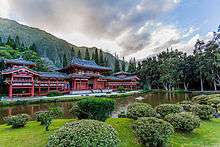Byodo-In Temple
| Byodo-In Temple | |
|---|---|
 Byodo-In Temple in Hawai'i is a replica of the historic Byodoin Temple of Uji in Kyoto prefecture of Japan, established in 1052. | |
| Basic information | |
| Location |
47-200 Kahekili Hwy Kaneohe, HI 96744 |
| Affiliation | non-denominational |
| Country | United States |
| Architectural description | |
| Completed | 1968 |
The Byodo-In (平等院) Temple is a non-denominational shrine located on the island of O'ahu in Hawai'i at the Valley of the Temples. It was dedicated in August 1968 to commemorate the 100-year anniversary of the first Japanese immigrants to Hawaii.[1] The temple is a replica of a 900-year-old Buddhist temple at Uji in Kyoto prefecture of Japan.[2] Contrary to popular belief, it is not a functioning Buddhist temple in the proper sense as it does not host a resident monastic community nor an active congregation.[3] Inside the Byodo-In Temple is a 18 ft (5.5 m) statue of the Lotus Buddha, a wooden image depicting Amitabha.[2] It is covered in gold and lacquer. Outside is a three-ton, brass peace bell.[2] Surrounding the temple are large koi ponds that cover a total of two acres (8,000 m²). Around those ponds are lush Japanese gardens set against a backdrop of towering cliffs of the Ko'olau mountains. Sparrows are often seen fluttering about and playing in the garden trees while peacocks strut about displaying their beautiful feathers. The temple covers 11,000 sq ft (1,000 m2).[4]
The Byodo-In Temple is visited and used by thousands of worshipers from around the world. It welcomes people of all faiths to participate in its traditions. Apart from worship, the temple grounds are also used for weddings and office meetings.
Ancient Japan
Byodo-In Temple is a half-size-scale replica of the Byodo-in Temple, a United Nations World Heritage Site near the ancient city of Kyoto, originally a monastery founded by Fujiwara no Yorimichi in 1052 of the Heian period. It was famous for its Vairochana statue. The statue was lost and replaced in 1053 with a large wooden statue of Amitabha (Amida Nyorai), a national treasure of the Empire carved by the Japanese artisan Jocho. Amitabha stands in the midst of the Phoenix Hall or Hoodo, an artistic reproduction of Amitabha Tathagata's Western Pure Land. It is called Phoenix Hall in reference to the two phoenixes stretching their wings upon the temple roof. Fifty two wooden images of Bodhisattvas surround the Amidtabha, dancing and playing musical instruments on floating clouds.
Since 2001, the temple has undergone restoration that will continue through 2007 in the spirit of preservation of Japan's ancient heritage.
Modern Hawai'i
Byodo-In Temple was commissioned and built largely by concrete (the original is wooden without the use of nails) in 1968 at its present location in the Valley of the Temples to celebrate the centennial anniversary of the arrival of Japanese culture to Hawai'i. It was dedicated by Governor John A. Burns, a favorite of the Japanese community for his long service for the cause of Japanese rights during the state's territorial years. Japanese immigrants entered the Kingdom of Hawai'i and later Territory of Hawai'i to labor in the sugarcane and pineapple plantations. They joined the Chinese, Filipino, Korean, native Hawaiians and Portuguese.
Byodo-In Temple previously housed the remains of Philippine dictator Ferdinand Marcos. His body was held in a mausoleum until it was moved back to the Philippines where it is now held in a refrigerated tomb.[5]
In popular culture
The TV series Hawaii Five-O and Magnum, P.I. featured several episodes where the temple is incorporated into the plot. The temple and its vicinity also served as a stand-in for South Korea in one episode of the ABC series Lost and as the Presidential Villa in an episode of seaQuest DSV.
The temple was also used in the 2001 movie Pearl Harbor as a replica of the Byodo-In Temple in Japan as well as several other movies.
Gallery
-
A young woman rings the peace bell prior to entering.
-
Byodo-In Temple as seen from the entrance bridge.
-
Mist-capped mountains loom above the temple.
External links
| Wikimedia Commons has media related to Byodo-In Temple, Oahu. |
- Temple website
- Three-dimensional rendering of Byodo-In (without plugin; in English, Spanish, German)
References
- ↑ "Temple Dedication". The Argus. September 8, 1968. Retrieved November 24, 2014 – via Newspapers.com. (subscription required (help)).
- 1 2 3 Gregg Patton (November 27, 1984). "Hawaii". The San Berdardino County Sun. San Bernardino, California. p. 63 – via Newspapers.com. (subscription required (help)).
- ↑
- ↑ "Republica of the famed Uji temple near completion in Hawaii". Independent PRess-Telegram. Long Beach, California. May 5, 1968. p. 90.
- ↑ [Manila Bulletin, accessed February 3, 2010 http://www.mb.com.ph/articles/227359/where-presidents-rest-peace]
Coordinates: 21°25′51.43″N 157°49′54.44″W / 21.4309528°N 157.8317889°W